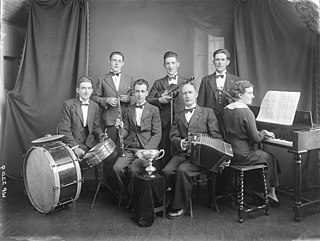The Belcea Quartet is a string quartet, formed in 1994, under the leadership of violinist Corina Belcea.

The String Quartet No. 1 in F major, Op. 18, No. 1, was written by Ludwig van Beethoven between 1798 and 1800, published in 1801, dedicated to the Bohemian aristocrat Joseph Franz von Lobkowitz. It is actually the second string quartet that Beethoven composed.

The Symphony No. 2 in D major, Op. 36, is a symphony in four movements written by Ludwig van Beethoven between 1801 and 1802. The work is dedicated to Karl Alois, Prince Lichnowsky.

A septet is a formation containing exactly seven members. It is commonly associated with musical groups but can be applied to any situation where seven similar or related objects are considered a single unit, such as a seven-line stanza of poetry. In jazz, a septet is any group of seven players, usually containing a drum set, string bass or electric bass, and groups of one or two of the following instruments, guitar, piano, trumpet, saxophone, clarinet, or trombone. See, for example, Miles Davis, and Chick Corea's 1984 album, Septet.
Sir Lennox Randal Francis Berkeley was an English composer.
The Simple Symphony, Op. 4, is a work for string orchestra or string quartet by Benjamin Britten. It was written between December 1933 and February 1934 in Lowestoft, using material that the composer had written as a child, between 1923 and 1926. It received its first performance in 1934 at Stuart Hall in Norwich, with Britten conducting an amateur orchestra.
Dmitri Shostakovich's String Quartet No. 3 in F major, Op. 73, was composed in 1946. It was premiered in Moscow by the Beethoven Quartet, to whom it is dedicated, in December 1946.
DSCH is a musical motif used by the composer Dmitri Shostakovich to represent himself. It is a musical cryptogram in the manner of the BACH motif, consisting of the notes D, E-flat, C, B natural, or in German musical notation D, Es, C, H, thus standing for the composer's initials in German transliteration: D. Sch..

The cello suites by Benjamin Britten are a series of three compositions for solo cello, dedicated to Mstislav Rostropovich. The suites were the first original solo instrumental music that Britten wrote for and dedicated to Rostropovich, but Britten had earlier composed a cadenza for Joseph Haydn's Cello Concerto in C major, for Rostropovich, in 1964. Rostropovich gave the first performances of each work, and recorded Suites Nos 1 and 2 commercially.

Quintet in E-flat for Piano and Winds, Op. 16, was written by Ludwig van Beethoven in 1796.
Joseph Haydn's Symphony No. 3 in G major, Hoboken I/3, is believed to have been written between 1760 and 1762.
The Melos Ensemble is a group of musicians who started in 1950 in London to play chamber music in mixed instrumentation of string instruments, wind instruments and others. Benjamin Britten composed the chamber music for his War Requiem for the Melos Ensemble and conducted the group in the first performance in Coventry.
Benjamin Britten's Sinfonietta was composed in 1932, at the age of 18, while he was a student at the Royal College of Music. It was first performed in 1933 at The Ballet Club, London conducted by Iris Lemare. It was published as his Op. 1 and dedicated to his teacher Frank Bridge.

String Quartet No. 3 in G major, Op. 94, by English composer Benjamin Britten was his last completed major work, and his last completed instrumental work. It was written in October – November 1975 during his final illness: the first four movements at his home, The Red House, Aldeburgh, and the fifth during his last visit to Venice, at Hotel Danieli. It was dedicated to the musicologist Hans Keller. In December 1975, brothers Colin and David Matthews performed it privately for the composer in a piano duet arrangement. During September 1976, Britten worked on it with the Amadeus Quartet; who premiered it on 19 December 1976 at The Maltings, Snape, two weeks after the composer's death.

String Quartet No. 2 in C major, Op. 36, by English composer Benjamin Britten, was written in 1945. It was composed in Snape, Suffolk and London, and completed on 14 October. The first performance was by the Zorian Quartet in the Wigmore Hall, London on 21 November 1945, in a concert to mark the exact 250th anniversary of the death of English composer Henry Purcell (1659–95). The work was commissioned by and is dedicated to Mary Behrend, a patron of the arts; Britten donated most of his fee towards famine relief in India.

The Zorian Quartet was an English all-female string quartet ensemble. It was founded in 1942 by and named after violinist Olive Zorian. It gave the premiere performances of, and made the first recordings of, several compositions for string quartet by English composers, including Benjamin Britten and Michael Tippett. It also gave the premiere English performances of quartets by Ernest Bloch and Béla Bartók.
String Quartet in D major by English composer Benjamin Britten was written in 1931. He revised it during his final illness, and it was first published in 1974.
The divertimenti in F major, B-flat major, E-flat major, F major, and B-flat major are five companion compositions for pairs of oboes, horns and bassoons by Wolfgang Amadeus Mozart.
Phantasy Quartet, Op. 2, is the common name of a piece of chamber music by Benjamin Britten, a quartet for oboe and string trio composed in 1932. In the composer's catalogue, it is given as Phantasy, subtitled: Quartet in one movement for oboe, violin, viola, violoncello. It was first performed in August 1933 as a BBC broadcast.






